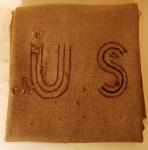
Civil War Envelope, 1861
Bangor Historical Society
By Dana Lippitt, Curator, Bangor Historical Society
On April 15, 1861 President Abraham Lincoln issued a proclamation calling forth the militia of the United States. The residents of Maine answered with enthusiasm and volunteers came forward to enlist in the newly-formed regiments. The Second Maine Regiment, consisting of men from Bangor and the nearby region left Bangor on May 14th, just one month after Lincoln's call for troops, and the first regiment to leave the state.

Frederick Rogers to his mother in Bangor, Oct. 11, 1861
Bangor Historical Society
One young Bangor man, Frederick H. Rogers, signed enlistment papers on May 3rd 1861. He mustered out on June 15, not with his friends in the Second Maine, but with Company K of the Fourth Maine. The Fourth Maine volunteers were from the Rockland and Belfast area were known as the Limerock Regiment. Frederick's father, Leonard W. Rogers, a carpenter, had died the previous August and his widowed mother, Hannah, certified that Frederick was 18 years old and had her consent as mother and guardian. He would not, however, celebrate his 18th birthday until later that year.
Three of the letters he wrote home to his mother survive in the collection of the Bangor Museum and History Center. They give us a glimpse of the life of a Maine soldier in the Civil War. At the time of Fred’s first letter, the Fourth Maine Regiment had been primarily engaged in the defense of Washington, D.C. They were encamped overlooking the Potomac and Alexandria Rivers near Franconia, in Fairfax County, Virginia two months after their involvement at Bull Run. Fred writes:

Hardtack, ca. 1865
The usual "bill of fare" for the Civil War soldier included hard tack. The flour and water cracker was often dunked in coffee or fried with bacon to make it more palatable. Fred was able to forage up a veritable feast for his birthday.Bangor Historical Society
(Note: These letters are transcribed as they were written with no corrections for grammar, punctuation, or spelling.)
Lawsons Hill Vir. 11 Oct
Dear Mother,
I received your epistle of the 6th, and A little fellow in it that done me a sight of good. Tody is my birthday and I have just celebrated it by A good dinner. I will give you The bill of Fare
Roast Turkey (captured while on Picket)
Sweet Potatoes (bought at the moderate Price of 3 cts apeace)
Oysters (Raw with pepper & Vinegar)
Hoe Cake Salt Beef Etc etc etc etc
So you see I did not fare so bad, after all. I shall send you A drawing of our cook tents , Camps, etc. with this to give you an idea of our mode of living. I suppose you have some trouble to read my writing, but you must get used to it for I cannot write any better not now and I think I never can learn to do any better.

Civil War boots, ca. 1864
These boots, manufactured by Bangor boot maker, John McGinty might have been just what Fred was hoping for.Bangor Historical Society
I should like very much to have some stockings and Mittens very much, and I must have A pare of Boots before
long A lot of the Belfast Boys are going to have them and I want you to find out what you can get A good pair on NO 8 or 9’s.
When we get paid up again I shall want a pair.
The weather is quite cold here, I was on picket last night and like to frose, although I had 2 Woolen Blankett and A good overcoat.

Civil War Army Blanket, ca. 1865
The blankets were often a light weight combination of wool and cotton.Bangor Historical Society
The 2d Maine Reg has moved from Ft Corcoran, and is now encamped about 4 Miles from Monsons Hill and I shall go and see them at the first opportunity.
I took A sketch of the country- and I will give you an idea of the place where we are encamped & picketed.
Our Reg has been partly furnished with Rifles and Co’s A & K are to have Winsor Rifles with sabre Bayonetts – they have come and we shall get them tomorrow or next day.
We get along as well as ever I feel contented and as well as ever I did – we shall no doubt have A fight in short time and shall walk our way through to Richmond.
Well I must wind up so goodby this time
Yours truly
Fred H Rogers
4th Maine Reg. 8th Brigade
USA





